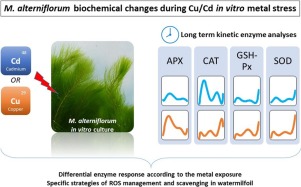当前位置:
X-MOL 学术
›
Aquat. Toxicol.
›
论文详情
Our official English website, www.x-mol.net, welcomes your feedback! (Note: you will need to create a separate account there.)
Myriophyllum alterniflorum biochemical changes during in vitro Cu/Cd metal stress: Focusing on cell detoxifying enzymes.
Aquatic Toxicology ( IF 4.5 ) Pub Date : 2019-11-15 , DOI: 10.1016/j.aquatox.2019.105361 Raphaël Decou 1 , David Delmail 2 , Pascal Labrousse 1
Aquatic Toxicology ( IF 4.5 ) Pub Date : 2019-11-15 , DOI: 10.1016/j.aquatox.2019.105361 Raphaël Decou 1 , David Delmail 2 , Pascal Labrousse 1
Affiliation

|
Given the toxicity of trace metals, their concentration, speciation and bioavailability serve to induce various plant detoxification processes, which themselves are specific to several parameters like plant species, tissue type and developmental stage. In this study, Myriophyllum alterniflorum (or alternate watermilfoil) enzyme activities (ascorbate peroxidase, catalase, glutathione peroxidase and superoxide dismutase) from in vitro cultures was measured over 27 days in response to copper (Cu) or cadmium (Cd) stress. These enzymes are unique to reactive oxygen species (ROS) scavenging (mainly hydrogen peroxide H2O2 and superoxide anion O2-) and moreover showed specific or unspecific activity profiles, depending on the metal concentrations used. Our results suggest a higher-priority protection of chloroplasts during the initial days of exposure to both metals. At the same time, the increased catalase activity could indicate an H2O2 diffusion in peroxisome in order to protect other organelles from ROS accumulation. However, as opposed to the Cd effects, high Cu concentrations appear to induce a "limited oxidative threshold" for some antioxidant enzymes, which could suggest an ion absorption competition between Cu2+ and Fe2+. In spite of an overall analysis conducted of the scavenging processes occurring in plant cells, biochemical analyses still yielded relevant indications regarding the watermilfoil strategies used for ROS management.
中文翻译:

体外铜/镉金属胁迫下互花米草的生化变化:集中于细胞解毒酶。
考虑到微量金属的毒性,它们的浓度,形态和生物利用度可诱导多种植物排毒过程,而这些过程本身对几种参数(例如植物种类,组织类型和发育阶段)具有特异性。在这项研究中,对铜(Cu)或镉(Cd)胁迫的反应在超过27天的时间内测量了离体培养物中的互花Myriophyllumlumniflorum(或替代的水银叶)酶活性(抗坏血酸过氧化物酶,过氧化氢酶,谷胱甘肽过氧化物酶和超氧化物歧化酶)。这些酶是活性氧(ROS)清除(主要是过氧化氢H2O2和超氧阴离子O2-)清除所特有的,此外,根据所用金属的浓度,它们还显示出特定或非特定的活性曲线。我们的结果表明,在暴露于两种金属的最初几天中,叶绿体具有更高的优先级。同时,过氧化氢酶活性的增加可能表明过氧化物酶体中有H2O2扩散,以保护其他细胞器免受ROS的积累。然而,与Cd效应相反,高浓度的Cu似乎对某些抗氧化剂酶诱导了“有限的氧化阈值”,这可能表明Cu2 +和Fe2 +之间存在离子吸收竞争。尽管对植物细胞中发生的清除过程进行了全面分析,但生化分析仍可提供有关用于ROS管理的水乳策略的相关指示。过氧化氢酶活性的增加可能表明过氧化氢在过氧化物酶体中扩散,以保护其他细胞器免受ROS的积累。但是,与Cd效应相反,高浓度的Cu似乎会诱导某些抗氧化剂酶产生“有限的氧化阈值”,这可能表明Cu2 +和Fe2 +之间存在离子吸收竞争。尽管对植物细胞中发生的清除过程进行了全面分析,但生化分析仍可提供有关用于ROS管理的水乳策略的相关指示。过氧化氢酶活性的增加可能表明过氧化氢在过氧化物酶体中扩散,以保护其他细胞器免受ROS的积累。但是,与Cd效应相反,高浓度的Cu似乎会诱导某些抗氧化剂酶产生“有限的氧化阈值”,这可能表明Cu2 +和Fe2 +之间存在离子吸收竞争。尽管对植物细胞中发生的清除过程进行了全面分析,但生化分析仍可提供有关用于ROS管理的水乳策略的相关指示。
更新日期:2019-11-18
中文翻译:

体外铜/镉金属胁迫下互花米草的生化变化:集中于细胞解毒酶。
考虑到微量金属的毒性,它们的浓度,形态和生物利用度可诱导多种植物排毒过程,而这些过程本身对几种参数(例如植物种类,组织类型和发育阶段)具有特异性。在这项研究中,对铜(Cu)或镉(Cd)胁迫的反应在超过27天的时间内测量了离体培养物中的互花Myriophyllumlumniflorum(或替代的水银叶)酶活性(抗坏血酸过氧化物酶,过氧化氢酶,谷胱甘肽过氧化物酶和超氧化物歧化酶)。这些酶是活性氧(ROS)清除(主要是过氧化氢H2O2和超氧阴离子O2-)清除所特有的,此外,根据所用金属的浓度,它们还显示出特定或非特定的活性曲线。我们的结果表明,在暴露于两种金属的最初几天中,叶绿体具有更高的优先级。同时,过氧化氢酶活性的增加可能表明过氧化物酶体中有H2O2扩散,以保护其他细胞器免受ROS的积累。然而,与Cd效应相反,高浓度的Cu似乎对某些抗氧化剂酶诱导了“有限的氧化阈值”,这可能表明Cu2 +和Fe2 +之间存在离子吸收竞争。尽管对植物细胞中发生的清除过程进行了全面分析,但生化分析仍可提供有关用于ROS管理的水乳策略的相关指示。过氧化氢酶活性的增加可能表明过氧化氢在过氧化物酶体中扩散,以保护其他细胞器免受ROS的积累。但是,与Cd效应相反,高浓度的Cu似乎会诱导某些抗氧化剂酶产生“有限的氧化阈值”,这可能表明Cu2 +和Fe2 +之间存在离子吸收竞争。尽管对植物细胞中发生的清除过程进行了全面分析,但生化分析仍可提供有关用于ROS管理的水乳策略的相关指示。过氧化氢酶活性的增加可能表明过氧化氢在过氧化物酶体中扩散,以保护其他细胞器免受ROS的积累。但是,与Cd效应相反,高浓度的Cu似乎会诱导某些抗氧化剂酶产生“有限的氧化阈值”,这可能表明Cu2 +和Fe2 +之间存在离子吸收竞争。尽管对植物细胞中发生的清除过程进行了全面分析,但生化分析仍可提供有关用于ROS管理的水乳策略的相关指示。


























 京公网安备 11010802027423号
京公网安备 11010802027423号